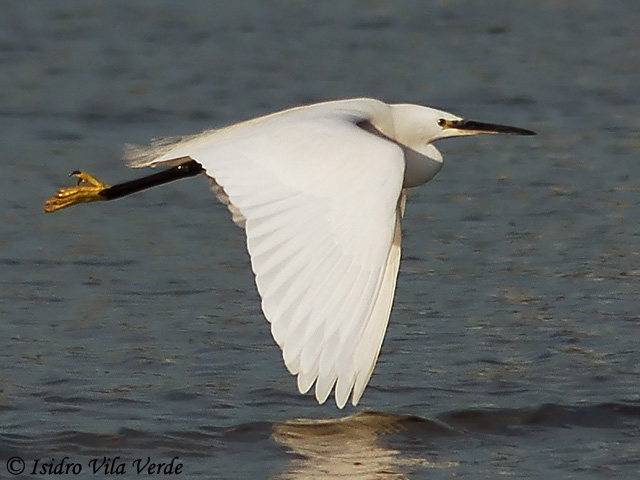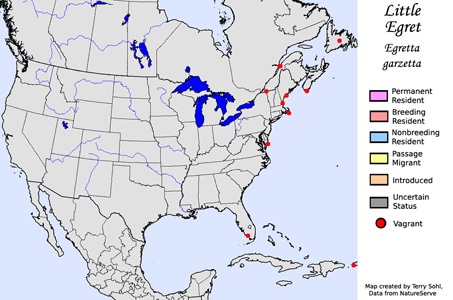Little Egret
Egretta garzetta
| Length: 24 inches | Wingspan: 42 inches | Seasonality: Non-resident in South Dakota |
| ID Keys: White plumage, dark legs with yellow feet, long breast plumes, dark grey lores and black bill | ||
 The
Little Egret is the Old World counterpart to North America's
Snowy Egret. Both are very similar in appearance, but the best
differentiation mark (other than geographic range) are the dark lores on
Little Egrets, compared to yellow lores on Snowy Egrets. The Little Egret is
one of the more widely distributed birds on the planet, with populations in
Europe, Asia, north Africa, and Australia. The Little Egret was only
recorded once in North America prior to 1980. However, since then,
there have been a number of sightings, with most occurring along the
coastline of the northeastern United States. They have also been
identified a number of times in the eastern Caribbean, and have started to
actively breed in the Bahamas.
The
Little Egret is the Old World counterpart to North America's
Snowy Egret. Both are very similar in appearance, but the best
differentiation mark (other than geographic range) are the dark lores on
Little Egrets, compared to yellow lores on Snowy Egrets. The Little Egret is
one of the more widely distributed birds on the planet, with populations in
Europe, Asia, north Africa, and Australia. The Little Egret was only
recorded once in North America prior to 1980. However, since then,
there have been a number of sightings, with most occurring along the
coastline of the northeastern United States. They have also been
identified a number of times in the eastern Caribbean, and have started to
actively breed in the Bahamas.
Habitat: Found in and around a variety of aquatic habitats. They will use both freshwater and saltwater habitats, including mangrove swamps, freshwater marshes, estuaries, and shores of rivers and lakes.
Diet: Feeds on a variety of items, including fish, amphibians, crustaceans, mollusks, insects and insect larvae, and other invertebrates. They also will on occasion eat small reptiles or mammals.
Behavior: Foraging techniques are varied, but includes wading slowly in the shallows and thrusting their neck and bill out to capture prey. They also will more actively wade, stirring up the bottom sediment and flushing fish, crustaceans, or other prey items. Little Egrets will also sometimes simply stand motionless and wait for prey to approach before striking.
Nesting: Colonial nesters, the nest of a Little Egret is a shallow platform of sticks. It may be placed in a tree, in dense shrubbery, or on the ground. The female lays 3 to 5 eggs, and both parents help to incubate them. When the eggs hatch, both parents help feed and tend to the young. The young may leave the nest after about 3 or 4 weeks, but typically stay in care of the parents for another couple of weeks.
Song: Has a raspy croaking call, and a hoarse chuffing call given in flight. They are usually fairly quiet away from their nesting grounds, however.
Migration: Over their broad geographic range in the Old World, many Little Egrets are migratory, moving to warmer climates for the winter. However, in more temperate and tropical climates, they may be semi-permanent residents.
Interactive eBird Map: Click here to access an interactive eBird map of Little Egret sightings
Similar Species: Very similar to the Snowy Egret. Also could be confused with Great Egret or Cattle Egret, and is very similar to the Old World's Intermediate Egret.
Conservation Status: Populations are stable or possibly increasing, they are found over a very wide geographic area, and they are common in many locations. The IUCN lists the Little Egret as a species of "Least Concern".
Further Information: 1) Royal Society for the Protection of Birds - Little Egret
2) Audubon - Little Egret
3) Oiseaux-birds.com - Little Egret
Photo Information: Photo taken by Isidro Vila Verde - December 26th, 2006 - Portugal - Licensed Under Creative Commons Attribution NonCommercial 2.0 Generic License
| Click below for a higher-resolution map |
 |
| South Dakota Status: Non-resident in South Dakota |
Additional Little Egret Photos (coming soon!!)
